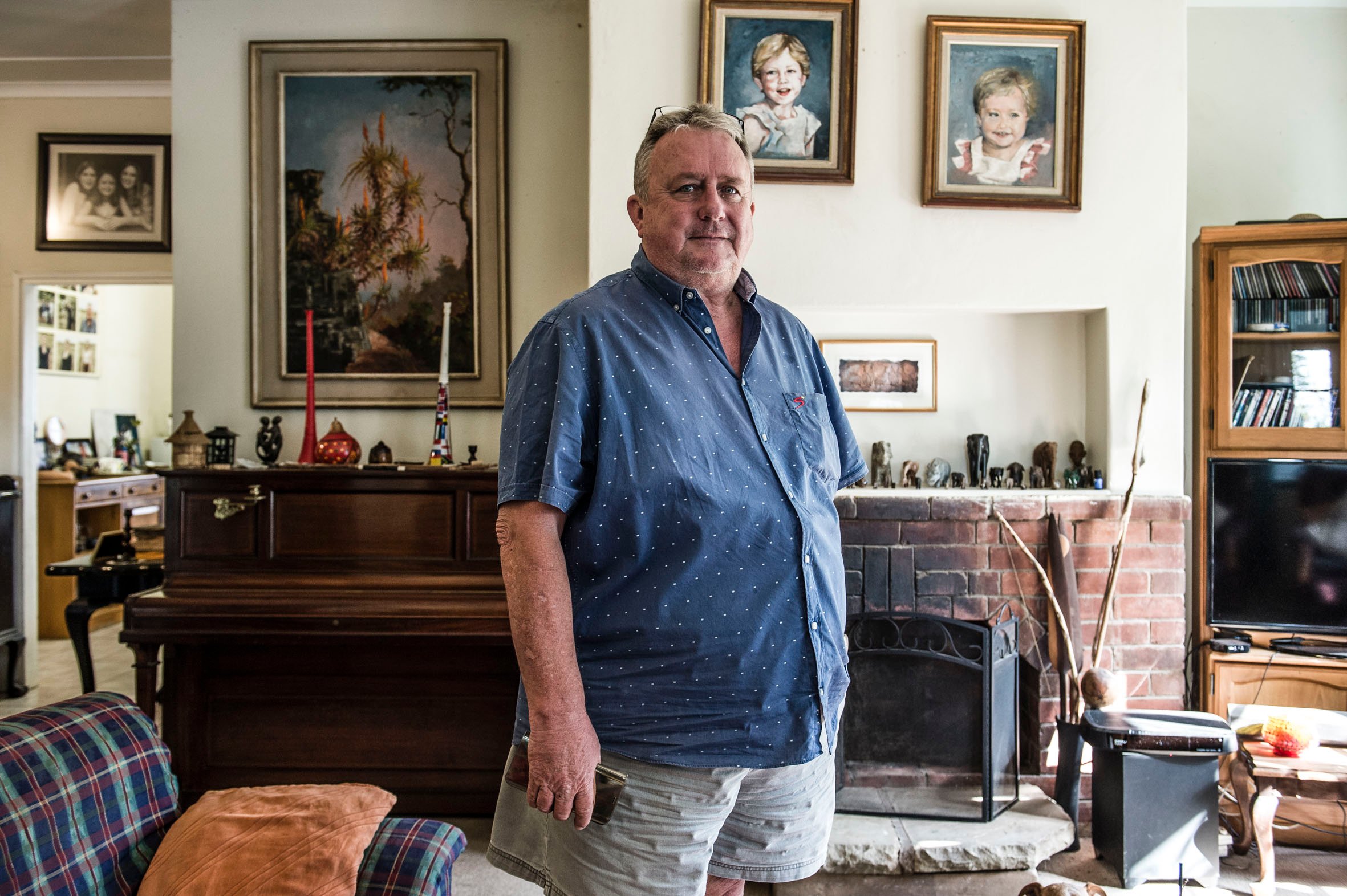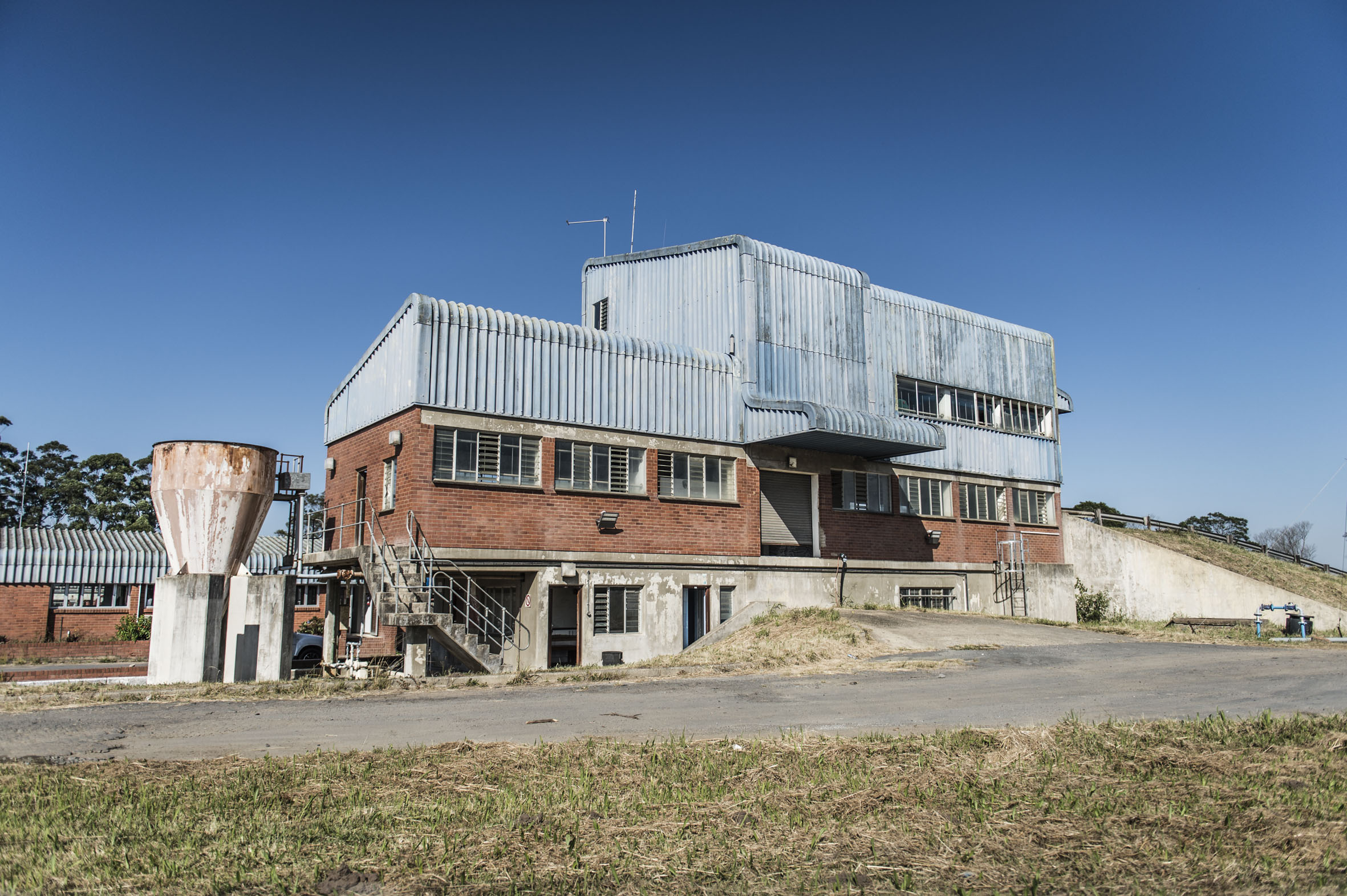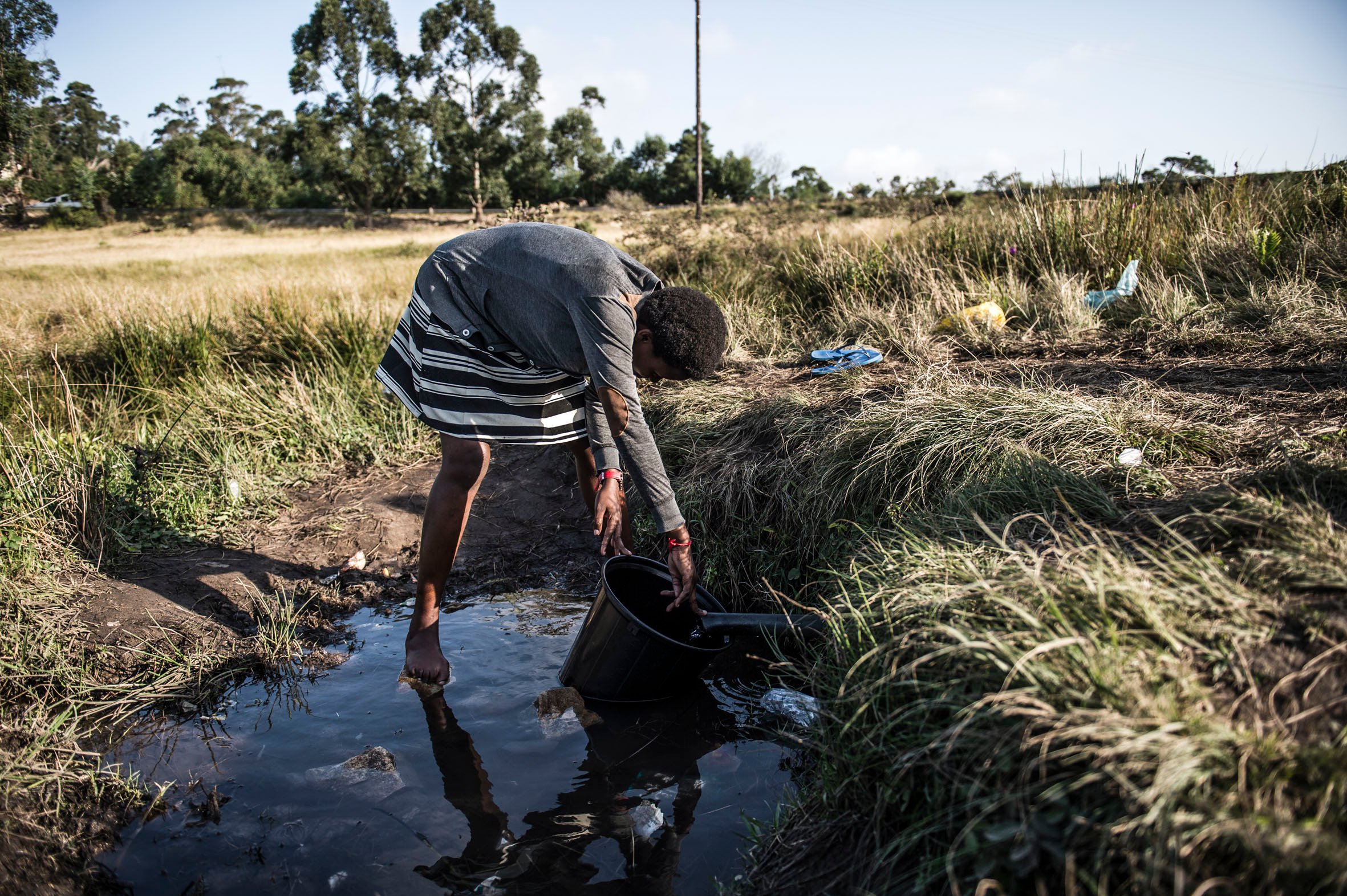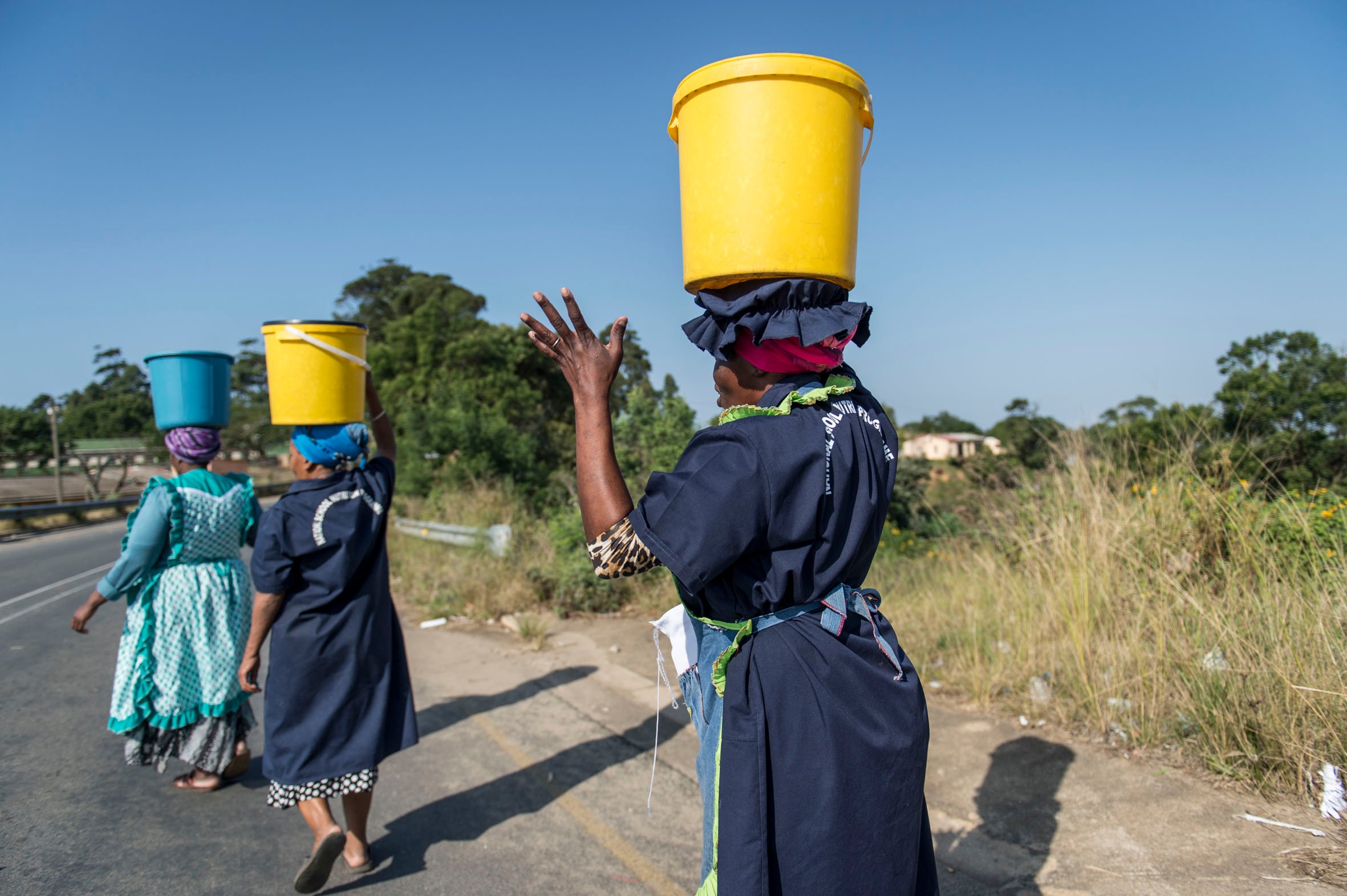Sibongiseni Xolo collects water at Manzamhlophe for his neighbours in his village KwaXolo. (Delwyn Verasamy/M&G)
A month after heavy storms tore through KwaZulu-Natal, Paddy Harper and Delwyn Verasamy visited the southernmost part of the province, where some villages still do not have water
There was not much of a celebration at the Ocean View guest house in Port Edward on Tuesday, despite the fact that the water supply to the South Coast town had just been restored after 25 days of dry taps.
Doug Powell, the chairperson of the Port Edward and Banners Rest Ratepayers and Residents Association, was not convinced that the Ugu district municipality had restored the Umtamvuna water works back to its full capacity of 21- million litres of water a day.
“We’ll have to wait and see,” he said. “So far there’s water in about a quarter of the town. The reservoir has to fill beyond 60% to build up enough pressure to supply the south of the town and the higher ground. The low-lying north part gets water first, and most of it.
“Once it’s up to full production, what’s going to happen? An air hammer is going to hit every weak point on the water pipeline that hasn’t had water moving through it for four weeks,” Powell said.
This is common in areas that haven’t had water for a while — the pressure from pumping exposes cracks and weaknesses in old pipelines and they explode.
Powell, like the majority of residents in the district, which includes holiday towns such as Margate, Port Shepstone, Port Edward and Uvongo, believes that it’s only a matter of time until the water system shuts down again because of ageing infrastructure — much of which is more than 25 years old — and inadequate maintenance.
“For the past 10 years the water supply has got exponentially worse,” said Powell. “Then, in 2017, a three-week outage over the festive season. Since then, pretty much every long weekend or holiday, there is no water and no explanation beyond that ageing infrastructure is being repaired.”
Powell said tourism, the main revenue spinner on the South Coast, had suffered: “Word has gotten out. People come here and find no water and cut their stay short or cancel when they check into B&Bs that aren’t self-sufficient.”
Powell said Ugu had failed to communicate with the association and other civic bodies about the crisis and its plans to deal with it. It had also failed to meet its own promise to supply water for two days — before cutting it off for five days — in the Southbroom to Port Edward area.
Last month the ratepayers’ body wrote to the co-operative governance and water and sanitation ministers demanding that they intervene at Ugu to prevent a humanitarian crisis from taking place.
“There has to be an intervention. This is hitting local business. Schools, clinics, doctors’ rooms don’t have water. We live in paradise here, but without water we are stuffed,” Powell said. “If the council had admitted early on that they were in a world of hurt and sent the alarm to whatever level they needed, they would have secured intervention by now.”
Powell said that in the interim those residents and businesses who could were installing tanks and boreholes, which cost between R120 000 and R150 000, to get off the municipal water grid. “Whatever intervention comes will take time. People are doing what they can now to secure their water supply,” he said.
“All any resident or business person cares about is being able to open a tap and get water. The president came down here after the floods and said this was a disaster area and that funding would be made available: what has happened with that?” Powell asked.
Dave Watson, the Democratic Alliance councillor for Ward 2 in the area, said the breakdown had been caused by the municipality’s “run to destruction” approach.

Dave Watson, the Democratic Alliance councillor in the Port Edward area, says the Ugu district municipality, responsible for Umtamvuna water works, is a failed entity. (Delwyn Verasamy/M&G)
“We have a water crisis here but we don’t have a shortage of water. There is no drought. Other than this current crisis the production of water is fine. The real problem is a dereliction of maintenance and last-mile reticulation; getting water to people’s houses,” he said.
Watson said the current crisis had come after disruptions of supply last year and a disaster at Port Shepstone in 2017 when sea water was allowed to wash into the area’s fresh water supply.
“This is a threat to our society and the people to blame for it are the Ugu council. It’s a failed entity — you can’t bleed R10-million a month and claim you are a going concern,” Watson said.
Ugu has come under fire from the auditor general in recent years, receiving a qualified audit for 2018-2019 over unauthorised expenditure amounting to R243-billion. The previous financial year, the auditor general gave Ugu a similar rating because of the municipality’s inability to account for property and equipment valued at R4-billion.
Watson said they had reported the municipality’s failure to function to the Human Rights Commission and had approached national government requesting intervention in terms of section 139 of the Constitution.
“We believe that the intervention will come but that what is being finalised is the detail — whether the whole council will be placed under administration or if it will focus purely on the provision of water,” Watson said.
He said estimates were that it could cost up to R2-billion to repair and replace damaged pipelines and upgrade Ugu’s water system to a level where it could provide for its more than 750 000 residents.
“We have got to a point where doing repairs is a waste of money because the next section goes as soon as one is fixed. There is a lack of standing operating procedures, trained staff and supplies,” he said.
Ugu spokesperson France Zama declined a request for an interview. In a generic statement, issued in response to detailed questions from the Mail & Guardian, Zama said that the water plant was back at full capacity and supply should be restored to all the affected areas by the weekend.
He said the outage had been caused by a broken pump, which had been repaired, and that the restoration of supply was being monitored.
He did not respond to questions about how much the municipality needed to maintain its water supply network, saying that a “substantial” amount had been budgeted for 2019-2020.
He did say that a process was under way to secure a new standby pump.
Zama also did not respond to questions about the call for Ugu to be placed under administration beyond saying that “our mandatory commitment as a water services authority of providing water and sanitation services shall never be deferred”.
But, for people who don’t live in KwaZulu-Natal’s tourist hotspots on the South Coast, these fixes mean little. The budget might mean water returns to the areas with more vocal and affluent ratepayers. Along the rolling valleys further inland, however, not having water is the norm.
“If I didn’t do this, people were going to die.’’
Sibongiseni Xolo was smiling, but there was nothing funny about the retired long-distance truck driver’s words as he waited on Monday afternoon for water to fill up the 50-litre barrels, loaded on to the back of his home-made trailer.
It was slow going. Xolo was using a length of hosepipe to siphon water into the barrels from the broken water main on the side of the road at Manzamhlophe near Izingolweni.
For the past three months, the 70-year-old Xolo, his tractor, manufactured in 1940, and a trailer cannibalised from an almost-as-ancient truck, have been a lifeline for people from the villages who are too old or sick to forage for water.

Water needs to be trucked in to affected villages and towns. (Delwyn Verasamy/M&G)
Asked what would happen if he did not make the trip from his village, KwaXolo, to the water source and deliver it to his vulnerable neighbours, Xolo’s response was blunt.
“I do this every second day,” he said.
The area should be serviced by municipal water tankers, but he said they either don’t go to his village or only come at night when people are asleep.
“There are old people and people walking with sticks,” he said. “They can’t get water for themselves. We have to do this.”
While much of the Ugu district municipality has been without water since the floods that ravaged the area in late April, destroying a pump at the Umtamvuna water treatment works, KwaXolo, Gcilima and other villages have been cut off for three to four months.

Umtamvuna water works. (Delwyn Verasamy/M&G)
The latest water outage has left about 175 000 people without water. The municipality’s plan, to give people water for 48 hours at a time on a rotating basis while repairing the damage, has failed to materialise.
The current water failure comes after months of interrupted supply during 2017 and 2018 throughout Ugu, which includes the coastal towns running from Scottburgh southwards to Port Edward and villages and farmland as far inland as Harding.
The municipality has been trucking water to affected villages and towns by tanker, but has been unable to reach them all.
“There are taps all the way along this road,” said Xolo. “They are all dry. I drove for more than 14km till I found water here.”
At Qombe, in Gcilima, Busi Mboyisa (25) and her mother Thandekile have one 100-litre tank of rainwater left for cooking and drinking for themselves and three children.

Children have to collect their water from a spring. (Delwyn Verasamy/M&G)
When it is finished, the nearest water supply is an old borehole, usually used by the village for irrigation, more than 1km away over a rutted, hilly road.
“The water is rusty. We boil it before we use it, but it still tastes bad,” said Busi, a communications graduate from the University of Johannesburg.
“When I came back from school in April there was no water and there has been none since. We haven’t been told anything by the councillor or the municipality about what is happening, [or] when it is coming back on,” she said.
“It is very tough. We have to walk very far to get water from the borehole. It’s old. People used to use it for farming and for cattle but now we are forced to use it too.”
In 2017, the family paid to have a standpipe connected to their yard from the municipal water supply, because the nearest communal tap is about 200m away, but the interruptions that have plagued Ugu mean they have seen no real benefit from it.
“We put in our own tap only to find there is no water now,” said Thandekile.
“I can’t push a wheelbarrow. My energy is finished. I’m staying with grandkids, who can help me? It’s lucky that Busi is home now. If she wasn’t, I don’t know what I was going to do.”
Outside the Umtamvuna water plant, where pumping resumed on Tuesday, Port Shepstone police officer Nosipho Khuzwayo and her daughters Zenande (7) and Sbongabonke (13) were filling a variety of containers with water from the standpipe in the road.
The two girls filled two-litre bottles to help their mother top up the 25-litre and 50-litre drums she had lugged — half-filled — to the boot of the family’s Toyota Tazz.
Khuzwayo, who had driven from KwaMphelelwa, in Ward 8, about 7km away from the tap, said she had to collect water every second day for her family of eight.
“I have a small baby who is three months so he needs fresh water. I come after a day. I have been doing this since the end of April. My twin is getting a rash from the water but we still have to use it,” she said.
“The taps just went dry. Ever since then there hasn’t been a drop of water in them. I even went to Ugu to report it. They said they would repair it but there has been nothing. They haven’t told us anything.”

Women each take a bucket from the closest river to a primary school for its nutrition programme. (Delwyn Verasamy/M&G)
This disaster is just one example of the failure of municipalities to get water to the people. Government says that about 95% of people in South Africa have “access” to water. But, in the Ugu district, access only means that there is infrastructure. It does not mean that water flows out of taps and brings life.
By its own admission, the national water department says that about a third of households don’t have regular clean water.
That’s 20-million people.
Tariffs add insult
The Ugu district municipality last week hiked its water tariffs by 18%, in the midst of the latest crisis preventing it from supplying drinking water to more than 175 000 of its residents.
The increase was levied by the council despite calls from opposition councillors to stagger the increase over two years to reduce the burden on residents. The council had wanted to hike the water rate by 22%, mainly to raise funds to repair and extend its reticulation system.